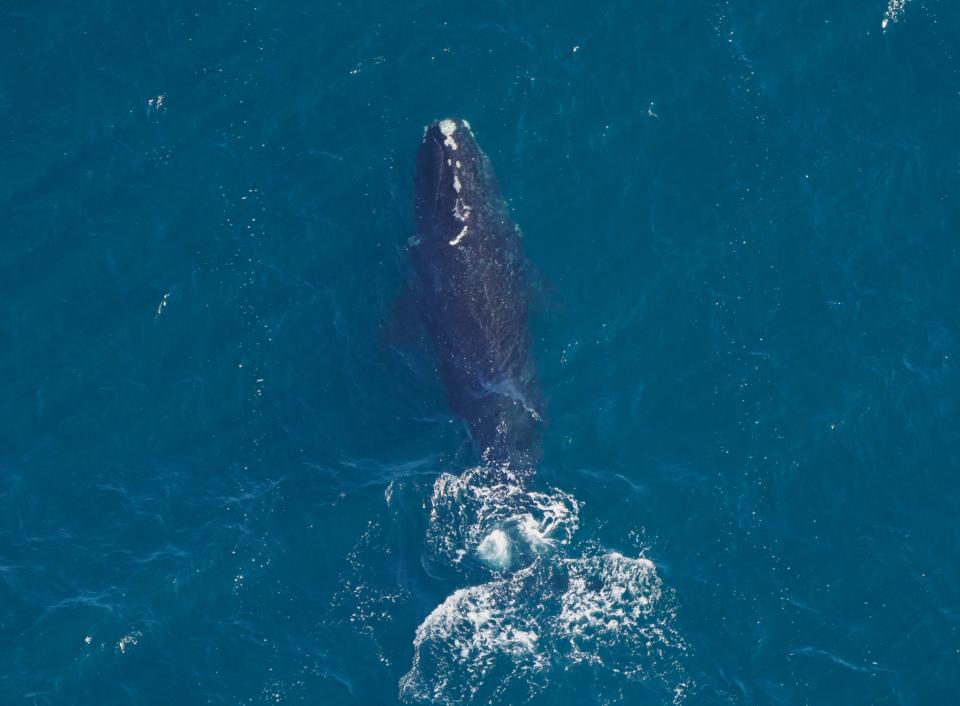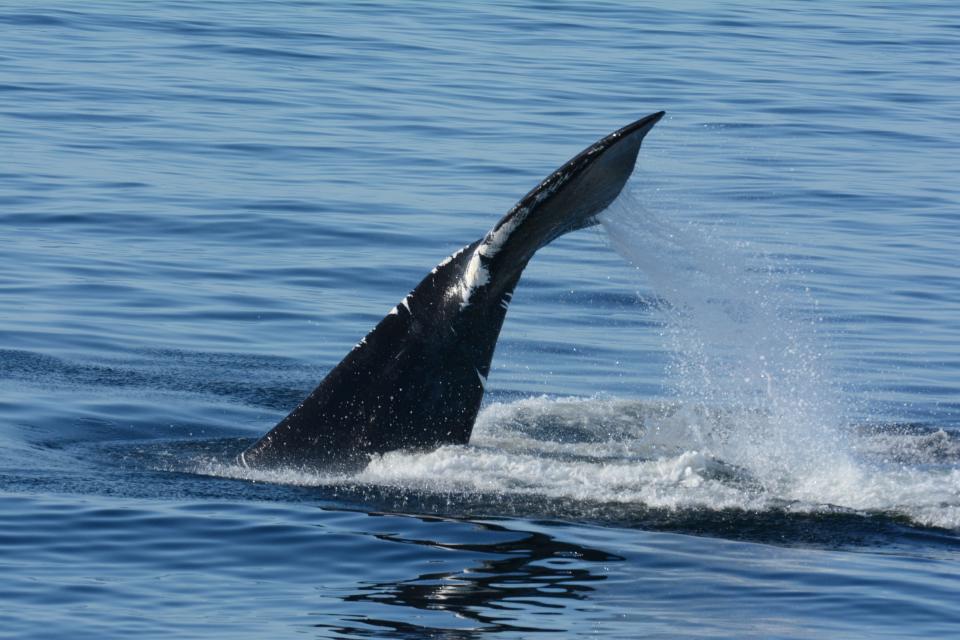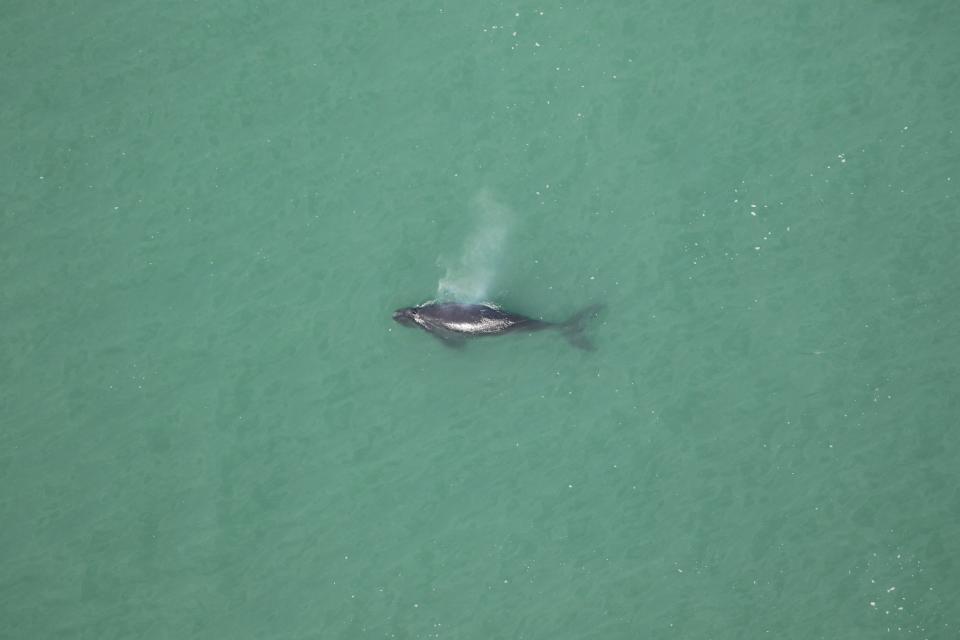This critically endangered whale is trying to make a comeback. Humans keep killing them.
The estimated population of North Atlantic right whales found off the nation’s East Coast was adjusted upward slightly in new estimates released Monday.
Scientists estimate the population at 356 animals, up from a previous estimate of 340, thanks in part to calves added to the population in recent years. The increase may mean an estimated 15% decline in the population since 2017 is slowing, but the coast is far from clear for the critically endangered marine mammals, said the North Atlantic Right Whale Consortium.
Human activities “are killing as many whales as are being born into the population, creating an untenable burden on the species,” said Heather Pettis, a research scientist at the New England Aquarium and the consortium’s executive administrator.
The consortium releases the annual estimates through a collaboration among scientists at the New England Aquarium’s Anderson Cabot Center for Ocean Life and the National Oceanic and Atmospheric Administration.
More: Saving endangered right whales pits advocates against lobstermen

How is the right whale population estimated?
The population estimates are adjusted each year based on the confirmed births and deaths. The aquarium manages a catalog that keeps track of thousands of whale photos taken to help identify individual whales based on their unique characteristics.
The main reason for the adjustments this year was the identification of calves born in previous years, said Philip Hamilton, senior scientist at the Anderson Cabot Center and the identification database curator for the consortium.

Even though scientists know from aerial surveys and whale monitoring that calves are born each winter, the calves aren’t added to the population estimate until each is identified adequately in photos so they can tell in future photos that it's definitely that whale, Hamilton said.
“Sometimes it takes several years of subsequent photographs before we'll get a photograph of that one little mark that we weren't seeing,” Hamilton said.
The information is reported to NOAA's National Marine Fisheries Service, which uses computer modeling to come up with the population estimate.
Based on the new identifications, the 2021 population estimate also was adjusted upward, to 364 from the previously estimated 340 whales, with a range of error estimated at +5/-4 whales.
“We encourage people to not focus so much on the number,” Hamilton said. “It’s more the trend of what the population is doing.”
The estimates do not indicate a stable population, said Kathleen Collins, senior marine campaign manager with the International Fund for Animal Welfare.
"They are a cry for serious collaboration between industry, government, and stakeholders," Collins said.
Why did the right whale population estimate increase this year?
The latest estimates reflect an increase in calving, but calving has not returned to the highs of the early 2000s.
Only 12 calves were born in the seasons of 2016-2017 and 2018-2019. Over the next three calving seasons, 44 calves were born. The 19 calves born in the 2019-2020 season led some to hope calving rates were increasing again, but last year only 12 calves were born.
Federal officials say more than 40 calves are needed each season to restore the right whales to a healthy, sustainable population.
Why is the outlook for the whales grim?
Fewer breeding females, too many human-related deaths from vessel strikes and fishing gear entanglements, and warming oceans that force whales into new feeding areas have created a grim outlook for many whales, according to the NOAA.
Since 2017, more than 100 whales have been confirmed dead or injured by human activities, the Monterey Bay Aquarium in California said in a statement Monday.
"This is one of the most endangered whale species on the planet and the measures taken to protect them have failed to adequately reduce the risks they face in the wild," spokesperson Kevin Connor said.
With fewer than 100 breeding females remaining, the death of even one right whale a year as the result of human-related causes is unsustainable, the federal scientists say. In 2023, two whales have been found dead, according to a federal database. A 20-year-old male was struck and killed by a vessel and a newborn male calf died.

So far this year, the New England Aquarium’s analysis has detected 32 human-caused injuries to right whales, including six fishing gear entanglements with attached gear, 24 entanglement injuries (with no attached gear) and two vessel strikes, Hamilton said.
The latest estimates don’t reflect the number of whales expected to die because they are entangled in fishing gear.
Dozens of whales are carrying fishing gear or show new entanglement scars on their bodies from ropes, traps and fishing gear, Hamilton said. At least four of those whales aren't expected to survive and another four are so entangled that scientists don't expect them to reproduce, according to a database that tracks whales in the latest ongoing unusual mortality event that began in 2017.
“That's one thing that we keep trying to stress -- while the downward trajectory in the population seems to be slowing, it takes years before the injuries and disappearances will show up in the sighting histories," Hamilton said. “Even though the population trend is flattening out, when you combine the number of whales that are hit by boats and entangled in fishing gear, that trend continues."
An estimated 66% of right whale deaths may go undetected, he said.
"It shouldn't be up to the right whale to have to give birth enough to accommodate the rate at which we kill them," he said.
For now, it's not even possible for the right whales for the species to reproduce at that rate.
Studies show young female whales aren’t growing as fast as they once did and may not be healthy enough to reproduce, he said.
An estimated 41 whales between the ages of 10 and 20 haven’t yet given birth to their first calf, even though the previous average age of a first-time mom was 10 years, Hamilton said.
“That’s really pretty alarming," he said.
Saving the right whales
Even though the population was adjusted upward, "we can't let our guard down," said Gib Brogan, campaign director for Oceana, an international ocean conservation advocacy group. "The scientists have told us that we are not past the point of no return for this species."
Oceana has urged the federal government to finalize its proposed updated vessel restrictions and do more to enforce vessel speed limit restrictions to protect the whales along their annual migration route. Female whales migrate along the Atlantic coast from Canada and New England to Georgia and Florida to give birth and are often accompanied by other whales.
"When we've talked to the shipping industry, they've told us they can plan it (the speed zones) into their voyages," and many commercial fishing boats already operate at or below the proposed limits, Brogan said. As for the recreational and charter industries, he said: "We think there’s a way for the boaters to work with those speed zones and give the whales the protection they need."
Hamilton, the scientist at the New England Aquarium, said the conversation all too often tries to pit fishermen against the whales, and he’d like to see that change.
"Fishermen don’t want to kill whales," he said. "It will take fishermen, biologists, and non-governmental groups working together to find a way for both to co-exist. It’s not impossible."
This article originally appeared on USA TODAY: North Atlantic right whale population update: How many are left?

